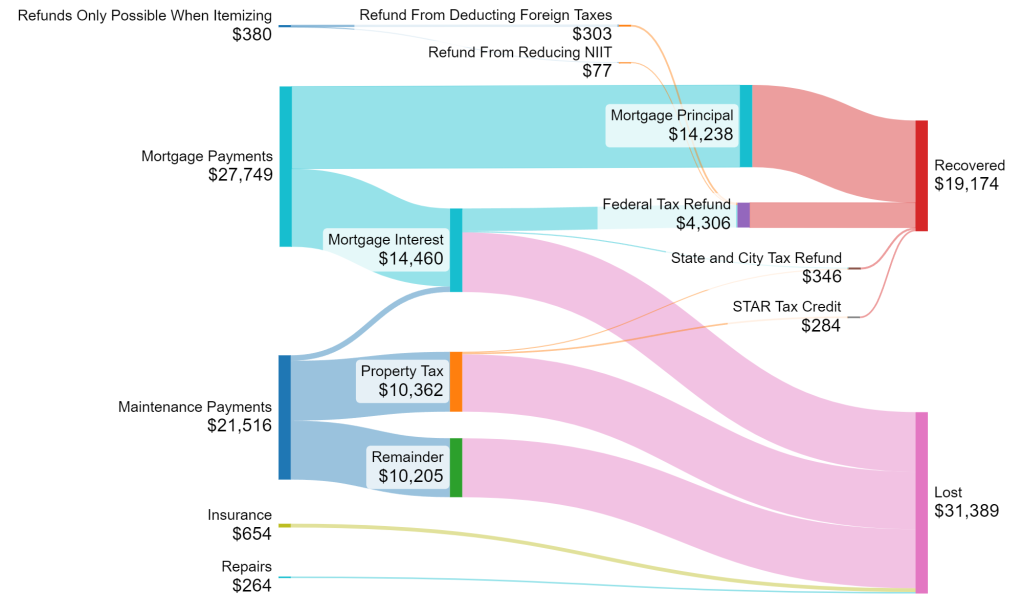tl;dr
- This post covers credit card churning, which is the process of picking up credit cards for the purpose of getting their sign up bonuses.
- I picked up 9 credit cards this year, earning $6,342 worth of points (which aren’t taxable, meaning they’re equivalent to a $12,133 pre-tax salary increase for me).
- These credit cards had credits and benefits at Dell, Uber, wireless providers, and airlines. I got $743 of value from those credits, which was nice but significantly below the face value of those credits.
- I met the minimum spend for these cards by paying my taxes, paying for (and reimbursing) business travel, and paying shared expenses on group trips.
- Subscribe using the box at the very bottom of this page to get notified when I post a getting started guide for credit card churning.
The basics
Sign Up Bonuses
This post is about credit card sign up bonuses, not optimizing using the right credit card to earn 3% back on a purchase vs 2%. Optimizing cash back on a given purchase can definitely yield some incremental value, but sign up bonuses result in a much higher percentage return, and better take advantage of the high spend that I assume many readers of this blog will have. Generally, this process of signing up for credit cards just for the sign up bonus is referred to as credit card churning.
Let’s start with a simple example: let’s say over the course of 3 months you spend $1,000 dining and entertainment, $1,000 on groceries, and $2,000 on a trip. You can optimize spending that money on credit cards that earn 3% or 4% on a given category, and you might earn a total of $160 worth of points in the best case. OR, you could put all that spend on the (arbitrarily chosen, not a referral link) Capital One Venture card, which gives you 100,000 points for spending $4,000 in 3 months. Points valuation is a tricky topic (see the next section), but those 100,000 points can be used to reimburse $1,000 worth of travel expenses, so we’ll say they’re worth $1,000. Subtract the $95 annual fee, and you have a $905 return on your spend vs the $160 best case return from just trying to optimize cash back categories.
Applying for and keeping track of a new credit card does take time. For the example above, as long as you spend less than 4.5 hours per card (I usually spend ~1-2 hours), you’ll be within my $200/hour rule for this blog.
Valuing Points
Many credit cards don’t give straight cash back, but instead give points of one form or another. I see two defensible ways to value points:
- Cash Back Value: Many points can be converted to cash back, and it’s reasonable to value points at their (easily extractable) cash value. For example, Capital One Miles can be used to reimburse payments at a rate of 1 cent per point (cpp). Chase Ultimate Rewards Points can be redeemed for 1.25 cpp through Chase Pay Yourself Back. Amex Membership Rewards Points can be redeemed for 1.1 cpp through the Invest with Rewards on the Schwab Platinum Card.
- Substitution Value: Many points can be redeemed for travel or other rewards. It’s reasonable to value them as equivalent to the cash you would have paid for the reward. For example, if you’d normally be willing to pay $600 to fly economy from New York to London and you can find a way to spend 30,000 points on the flight instead, it’s totally reasonable to value those points at 2 cpp. If that same flight costs 50,000 points in business or $3,000 cash, it is not reasonable to value those points at 6 cpp unless you would have been willing to pay the cash value to fly business class. When valuing points with this method, the key idea is keeping in mind what you would have paid in cash, NOT the cash value of what you got.
Regardless of the valuation method, remember that the value of points are only realized if they are used. If you accumulate 1,000,000 points at the 2 cpp discussed above and then never spend them, you haven’t made $20,000; you’ve made $0 (and probably lost money on the annual fees of the cards you got).
Regardless of which valuation method you choose, stay away from using the valuation given by popular sites like The Points Guy because they inflate the value of points. For example, they value the Amex Membership Rewards Points at 2 cpp vs the value of 1.1cpp above. They inflate the value of points because they make money through affiliate programs that pay them when you sign up for a credit card through their links.
My Returns
Bonuses Earned
These are the cards I got last year, with the spend requirements they had, the points they earned, the value I placed on their points, and the annual fees I paid:
| Card | Spend Requirement | Points Reward | Cents Per Point (cpp) | Annual Fee (AF) | Final Value (points * cpp – AF) |
| Chase United MileagePlus Explorer | $3,000 | 60,000 | 0.51 | $95 | $205 |
| Amex Gold (Retention Offer2) | $3,000 | 30,000 | 1.1 | $1503 | $180 |
| Chase Ink Business4 Unlimited | $6,000 | 75,000 | 1.25 | $0 | $937 |
| Chase Sapphire Preferred | $4,000 | 80,000 | 1.25 | $95 | $905 |
| Amex Business Platinum (Authorized User5 Card) | $4,000 | 20,000 | 1.1 | $0 | $220 |
| Amex Business Platinum (Authorized User Card) | $4,000 | 20,000 | 1.1 | $0 | $220 |
| Chase Ink Business Preferred | $8,000 | 100,000 | 1.25 | $95 | $1,155 |
| Chase Ink Business Cash | $6,000 | 90,000 | 1.25 | $0 | $1,125 |
| Amex Business Platinum | $15,000 | 190,000 | 1.1 | $695 | $1,395 |
The total cash value of points I earned from these credit cards last year was $6,342. Note that credit card signup bonuses are generally considered to be rebates, and thus aren’t taxable. So I would have needed another $12,133 in my paycheck to end up with that $6,342 after taxes.
Other Benefits
The cards I got this year also came with some benefits that had a pretty concrete cash value:
- $120 ($10 / month) worth of uber credits from my Amex Gold card. I pretty consistently used this up passively through Ubering / Uber Eats, so I valued it at full value ($120).
- $8006 at Dell from my Amex Business Platinum credits. Everything at Dell is incredibly over priced, but I got some items I did want (two routers, a web cam, a mic, and a Pixel Watch 2). These items were significantly more premium (and thus more expensive) than the items I would normally have bought. Adding up what I would have otherwise been willing to spend, I think I saved about $153. Note that there are better ways to extract value from this credit if you’re really trying7.
- $120 Wireless Credit from my Amex Business Platinum. They didn’t correctly apply this credit to my Google Fi bill, and when I mentioned it while closing the card they were only able to give a $20 credit, so I’ll value it at $20.
- $6008 Airline Fee Credit from my Amex Business Platinum. This is easily converted to United Travel Bank cash. I find United is consistently priced a bit higher than other airlines on routes that I fly, but by using these credits I was able to book a flight that would have cost ~$450 on another airline. So I got $450 in value from these credit this year.
Adding these $743 in value to the $6,342 in bonus points from the previous section adds up to a grand total of $7,085 this year.
Note that these cards did also offer some other benefits which I attach no cash value to, but which did contribute to my quality of life (e.g. lounge access, free checked bags, and earlier boarding times).
How I Meet Spend Requirements
An astute observer will notice I had to spend $53,000 to earn my 2023 credit card bonuses. That would be a lot if I was just swiping my card for groceries and the occasional meal out. Here are some other big ticket items I have or can pay for by credit card that you might not have expected (each of which probably merit their own posts):
- Taxes: Given that RSU taxes are chronically under-withheld, I always end up owing additional taxes and opt to make quarterly estimated payments. Conveniently, the IRS lets you pay taxes by credit card for a fee as low as 1.82%9. Four simple quarterly payments accounted for ~$28,000 of my credit card spend.
- Business Travel: I went on a few trips for work in 2023. While flights are paid directly by the company, hotels can be put on a personal card10 and reimbursed. This contributed to ~$9,000 of my credit card spend.
- Shared Expenses: I tend to be the organizer for group outings, which often earns me the right to book group flights, rent AirBnBs, buy tickets, pay for meals, and other expenses (and then Venmo charge the attendees after). This contributed ~$8,000 of my credit card spend.
If I’d been going more aggressively for sign up bonuses, there is other spend that I could have put on a credit card (for a fee), such as my mortgage or co-op maintenance fees. There is also an entire world of Manufactured Spend that is beyond the scope of this post.
Doesn’t getting so many cards hurt your credit score?
I started the year with a FICO score of 798, ended it with a score of 797, had a minimum of 785 and a maximum of 803. So in short, no, it hasn’t tanked my credit score11. That said, it can affect some credit scores more than others, and you definitely wouldn’t want to risk even a few point drop in credit-sensitive situations like trying to get a good mortgage rate.
If You Want to Get Started Churning
Ultimately this post isn’t meant to be a comprehensive how to guide. If you’re looking to get started, the r/churning subreddit and Doctor of Credit have some guides, but note that they have gotten a bit stale. I do plan on making an up to date getting started guide, so subscribe using the box at the very bottom of the page if you want to be notified about it (and leave a comment if you’d like me to prioritize that guide over other content).
In the mean time, if you want to see what’s currently going on in the world of churning (as well as look back through the archives for some timeless knowledge) here are some resources I’ve found useful:
- Doctor of Credit: Well respected all-around resource for churning information and money making deals. Be warned that they tend to cover a lot of content that won’t meet the $200 / hour rule.
- Frequent Miler: Fairly beginner friendly all-around churning and travel site.
- Miles to Earn and Burn: A high-signal, short, to the point newsletter that tends to skew a bit more advanced. They cover a ton of very timely news, with the occasional bits of evergreen wisdom interspersed.
- r/churning: Has some decent wikis and the occasionally very good high effort post on miscellaneous churning related topics. Though be warned that the comments can often get very toxic, so while this is where I got my start learning about churning, it’s not always a nice place for beginners to participate in the discussion.
- Your local group: Many large cities have churning meetups / chats that you can join (eg. NYC has Point Me to NY). These can be a good place to find a friendly community of people to chat with about the hobby both in person and online.
- 0.5cpp is a pretty low value to place on United Miles by most standards. The reason I chose it is because I was accumulating these miles to fly myself and my partner to Italy in Business Class, but if booking with cash we would have flown economy. When comparing the points vs cash values in economy, the United points worked out to about 0.5cpp relative to the cheapest cash flights I could find (regardless of airline). ↩︎
- I applied for this card in 2022 and got a sign up bonus. When I called in to cancel in 2023, I received this offer to keep the card instead. It was minimal effort and ROI positive so I decided to keep the card. Check out this great article on how to get retention offers for your credit cards. ↩︎
- The annual fee for this card is actually $250, however, I have an American Express corporate card through work, which lets me take advantage of the Corporate Advantage program to reduce my annual fee by $100 ↩︎
- You’d be surprised how easy it is to get a “business” card. I personally have done software contracting in the past and use that to justify my business cards, but many others have gotten business cards with much less justifiable businesses (e.g. “I occasionally sell stuff on Facebook Marketplace”). Business cards can usually be applied for with just an SSN (no corporation needed), an many do not report on your personal credit report. ↩︎
- Many business cards offer bonuses for adding authorized users to your existing credit card. This doesn’t result in a new credit application, and can even be done without an SSN for the authorized user (although Amex will close the card after 60 days if you do not provide an SSN). These cards are much lower effort to open than a new credit card, but often have proportionately lower rewards. ↩︎
- The astute reader will note that Amex only gives $400 per calendar year in Dell credits, split into $200 for the first half, and $200 for the second half. I did what’s called an Amex triple dip, applying for this card at the very end of 2022 and cancelling before the second annual fee posted in 2024. That let me use the second 2022 credit, as well as the first 2024 credit, for a total of $800 in Dell credits. ↩︎
- For example, buying groups will often pay face value for items bought from Dell, but that’s an advanced topic beyond the scope of this post. ↩︎
- Just like the Dell credits mentioned in the footnote above, this was a triple dip. ↩︎
- Many things that are traditionally paid using cash can often be put on a credit card for a fee. This fee is intended to balance out the interchange fee the merchant pays for accepting the card. Paying a credit card fee to meet a sign up bonus is usually worth it given the high cpp value of the sign up bonus, but the fees paid are important to factor in when calculating how much you actually made from a sign up bonus. Note that a 1.82% fee to pay taxes is exceptionally low for a credit card fee, and is partially counteracted by the 1-1.5% points that most cards earn on all purchases. ↩︎
- If you read the previous footnotes you’ll know that I have a corporate card. For big purchases like a hotel, it makes a ton of sense to put them on a personal card to help in hitting a sign up bonus (and just to earn points). Smaller purchases, like any individual meal, don’t always make sense to put on a personal card. Yes, you’ll earn points and work towards a sign up bonus, but if you forget to expense a single item you’ll end up eating a cost that is probably bigger than all the points you earned from all the other expenses on your trip. ↩︎
- The why is a topic for a whole post on it’s own. But the short version is that it comes down to the 5 factors that go into a FICO score. “Payment history” (35%) and “Credit mix” (10%) are unaffected by churning (assuming you pay your new credit card bills). “Amounts owed” (30%) can actually improve, because the calculation rewards you for having a lower percentage of your available credit in use, and getting new cards increases the denominator in that calculation. “Length of credit history” (15%) will go down, but the more cards you have open the less of an effect each new one has on the average. “New credit” (10%) is the final factor, and it definitely does ding your score, but I’ve noticed the effect to be limited and short lived. Finally, many business cards (of which I got a few this year) do not report on a personal credit report, and so the only effect they have on your credit comes from the initial credit inquiry. ↩︎




Leave a comment